There is no doubt that Wes Montgomery (aka The Thumb) was one of the most legendary players of all time. He was one of the best single-line soloists in jazz history, on the guitar or otherwise. His lines had driving rhythm, interesting note choices and always had a sense of melody and melodic development that has made him stand out from his peers for the past 60 or so years.
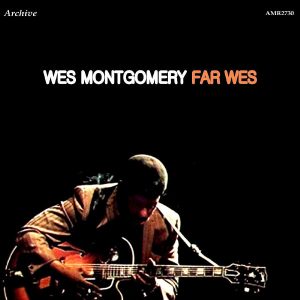
A true legend, Wes Montgomery left a huge impression on the jazz community with his recording output, inspiring future generations of guitarists to pick up the guitar and explore the jazz idiom at the same time.
Beginning his career by learning and performing note-by-note transcriptions of Charlie Christian solos, Wes quickly moved on to become one of the most influential guitarists from his, or any, era. His influence can be heard in the playing of great guitarists such as Pat Martino, George Benson, Pat Metheny, and Emily Remler, just to name a few. You would be hard-pressed to find any jazz guitarist that wasn’t influenced by Wes’ playing at one point or another in their development.
Since Wes was such a powerhouse in the jazz guitar world, it is a good idea to spend some time studying his licks, phrases, and improvisational concepts, which is what this lesson is designed to do. So, grab your favorite axe (an L-5 if you have one handy) and begin exploring these commonly used phrases and improvisational concepts taken from the playing of one of the greatest jazz guitar players of all time, Wes Montgomery.
Recommended listening: Smokin’ at the Half Note (live)
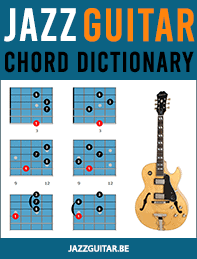
THE JAZZ GUITAR CHORD DICTIONARY (FREE eBOOK)
Download now and learn 244 chord shapes!
Wes Montgomery Lick List
How to Practice These Licks
To help you take the licks on this page further in your practicing and performance ideas, here are a few exercises that you can use to work these phrases into your playing.
- Before you learn how to play any lick, check out the theory behind the phrases to figure out the building blocks of the line, allowing you to create your own similar lines in the future.
- Play the licks in different keys across the neck.
- When studying a lick, find at least one other fingering in a different part of the neck.
- Transpose licks up or down an octave to have them available in at least two ranges on the neck.
- Begin to alter the lick in your solos by changing the rhythms, adding notes into the phrase and taking notes away in order to make it less of a memorized phrase and more of a part of your playing overall.
Wes Montgomery’s Minorization
One aspect of Wes Montgomery’s signature sound is the minorization of dominant chords.
Have a look at a C9 chord, which is a C dominant chord (C7) with extension 9 (D):
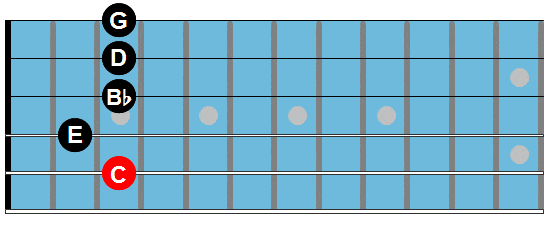
And compare it to a Gm7 chord:
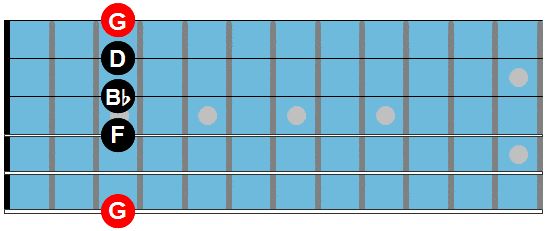
You will notice that a lot of notes of these two chords are the same:
| C9 | C | E | G | Bb | D | |
|---|---|---|---|---|---|---|
| Gm7 | G | Bb | D | F |
Instead of just playing the notes of C7 over C7 chords, Wes Montgomery would often play the notes of Gm7 over C7.
This results in a more colorful sound because:
- The 9 (D) of C7 is added
- The 3rd of C7 (E) is substituted by the 4th (F), which results in a sus sound.
It doesn’t stop there though. He goes one step further by playing Bbmaj7 over C7. Bbmaj7 is a common substitute for Gm7, which means you can also play it over C7:
| C7 | C | E | G | Bb | D | ||
|---|---|---|---|---|---|---|---|
| Gm7 | G | Bb | D | F | |||
| Bbmaj7 | Bb | D | F | A |
The Bbmaj7 adds yet another tension to C7: the 13.
Wes combines these 2 (Gm7 and Bbmaj7) to play over C7.
Sometimes he plays the four-note arpeggio, sometimes he plays triads (Gm and Bb).
Minorization Example 1
Here’s an example from Wes Montgomery’s solo on Unit 7, in which you can recognize the 2 following arpeggio shapes:
Gm7 arpeggio
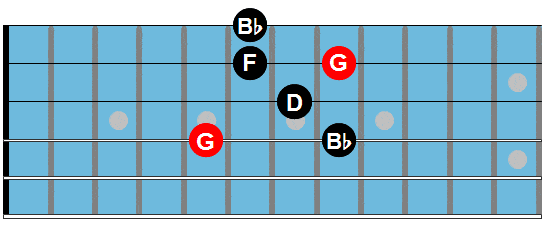
Bbmaj7 arpeggio
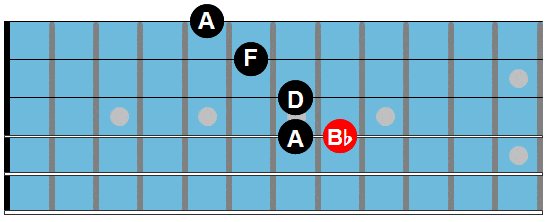

Minorization Example 2
Here’s another example, in which you will recognize the following two arpeggio shapes:
Bbmaj7 arpeggio
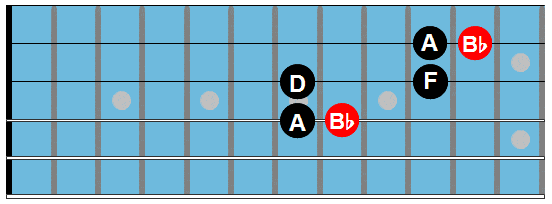
Gm7 arpeggio
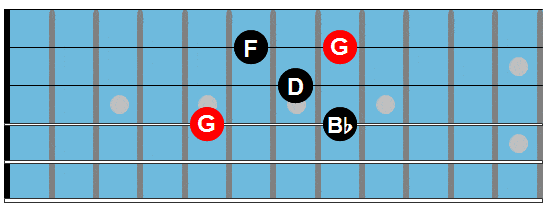

Here I start with the first Bbmaj7 arpeggio shape.
Then I approach notes from the first and the second shape (Gm7 arpeggio) chromatically, by sliding into them.
I end on a phrase using the Gm7 arpeggio.
One more thing about minorization: we learned that you can play Gm7 over C7.
If you add the 4th to Gm7 you get a G minor pentatonic scale. The 4th of G is C, the root of C7, so the minor pentatonic scale of G works perfectly over C7.
| G Minor Pentatonic Scale | G | Bb | C | D | F |
|---|---|---|---|---|---|
| Played over C7 | 5 | b7 | 1 | 9 | 4 |
In summary, here is the rule of thumb:
To play over a dominant chord, you can play the notes of a:
1) Minor 7 chord that is a 5th above the root of the dominant chord. For example: Gm7 over C7.
2) Major 7 chord that is a major 2nd below the root of the dominant chord. For example: Bbmaj7 over C7
Wes Montgomery Patterns
Learning jazz guitar vocabulary often means studying lines and phrases, breaking them down and understanding the building blocks of each line so that you can create your own improvised lines and phrases.
As well as studying longer lines, and breaking them down on your own, you can also study mini licks or patterns, lines that are 1 to 4 beats long, that you can then combine in your playing to create improvised lines in your solos.
In this section, you will learn four patterns in the Wes style that you can add to your vocabulary, as well as combine in order to create longer phrases when bringing these ideas to your jazz guitar soloing lines and phrases.
Minor Pattern
The first mini-lick is a m7 phrase that comes from Wes’ concepts and is based on the 3 to 9 arpeggio. This means that when playing over Am7, you are using the Cmaj7 arpeggio to outline a rootless Am9 sound:
| Cmaj7 Arpeggio | C | E | G | B |
|---|---|---|---|---|
| Played over Am7 | b3 | 5 | b7 | 9 |
To help close the line, the second last note is the root, which helps resolve the Cmaj7 sound. But, you don’t necessarily have to have the root in your line when playing 3 to 9 arpeggios, that is up to you.
Listen & Play Along

Dominant Pattern
Moving on to a dominant chord, here is a pattern that uses a trill (G-A-G), as well as a leap from the 3rd (F#), to the root (D).
This type of large leap (from the 3rd up to the root), is characteristic of Wes’ lines and helps to break things up when using chord tones, rather than simply running up or down the arpeggio in your playing.
Listen & Play Along

Major Pattern
You will now learn a mini lick over a maj7 chord, which features to approach notes:
- F# to G: a lower approach note.
- C to B: an upper approach note.
These two approach notes highlight the root and 3rd of the underlying chord, and use the 7 and 4 of the key to lead into those notes by half step.
Playing 5-7-1-4-3, which is the main interval pattern of this lick, is commonly used by Wes, and again, is a great way to break up chord tones so they aren’t played in order.
Listen & Play Along

Altered Dominant Pattern
The final mini lick uses tension notes over E7alt, before resolving back to the Am7 (iim7) chord in the progression.
Listen & Play Along

Wes Montgomery Combined Lick
To finish your study of these Wes Montgomery patterns here is a longer phrase that is made up of the four mini licks you learned previously in this lesson along with a few connector notes to make the longer line sound smooth.
I’ve also moved a few of the licks to other positions of the neck to help them all connect. Moving lines to other fingerings, in the same key, is an essential practice tool when learning jazz guitar lines such as these as it helps you quickly access them no matter where you are on the fretboard during your solo.
This is just an example of how you would combine these smaller ideas to form a longer phrase, so make sure to experiment with connector notes between the licks, as well as bringing in a few mini licks and improvising the rest of the line when taking these ideas further in your practice routine.
Listen & Play Along

Short II V I Licks – Major
When studying jazz guitar, one of the toughest progressions to begin outlining in your solos is the short ii V I progression.
With three chords in two bars, this chord progression goes by quickly, providing a challenge for all levels of guitarists. When learning how to play over these fast-moving chord changes, one of the best study approaches is to learn from the greatest names in the genre. And, there’s no bigger name than Wes Montgomery.
In this section, you’ll learn 7 different Wes Montgomery ii V I licks over short changes, both major and minor, as well as a sample solo over the Miles Davis tune Solar.
By working on these lines, you’ll expand your vocabulary, as well as learn concepts that you can use to bring a Wes vibe into your own solos.
Short II V I Lick 1 – Major

There are three concepts in this lick that you can take out of this context and study on your own in order to be able to build Wes style licks of your own.
- The first concept is the F triad being used to outline the Dm7 chord in the first half of the first measure. The F triad (F-A-C), outlines the b3, 5 and b7 of the Dm7 chord, giving you all the sounds you need to outline that change without hitting the root at any point.
- There is also the use of the G Mixolydian mode over the G7 chord (the notes E-F-E-C in the second half of the first bar). This is a pretty common mode choice over G7, and it’s one that Wes used often in his playing. Of note, is the pull-off from the F to E (b7 to 6), which helps propel the line forward rhythmically, moving beyond the note choices themselves.
- The last item is the use of the blue notes in the first and second bar, which come from the C minor blues scale. Playing the tonic blues scale, in this case C since the chord progression is in C major, over any chord in a ii V I is something that Wes did often, and it’s a big reason why he had such a bluesy sound in all of his improvised solos.
Short II V I Lick 2 – Major
Listen & Play Along

- The first line uses chords tones in the first bar to outline each chord change.
- There’s also a characteristic leap from the 3rd to the root of the F7 chord, which you can hear in many of Wes’ solos.
- Over the Bbmaj7 chord, there’s a blue note added between the 3rd and 2nd of the scale, the Db note which is the b3 over Bbmaj7. Mixing blue notes into your arpeggio and scale lines will bring a Wes vibe into your lines, as it’s something Wes did constantly in his playing.
Short II V I Lick 3 – Major
Listen & Play Along

- This second line begins with ascending 3rd intervals, something Wes was found of using in his solos.
- From there, the line stays within the diatonic scale for each chord.
- Notice the last two notes over Bbmaj7, where you’ll be using the 4th (Eb), to resolve to the 3rd (D). This >half-step movement is commonly used over maj7 chords to create a bit of tension, as the 4th clashes with the 3rd in the chord, before resolving down to the 3rd.
Short II V I Lick 4 – Major
This final major ii V I line uses two blue notes over both the F7 and Bbmaj7 chords.
Listen & Play Along

- Over the F7 chord, you’ll use a b3 blue note, the G# (Ab) near the end of the bar.
- In the second bar, you’re using the b5 blue note (E over Bbmaj7), as you create a bluesy sound in the first half of that bar.
By adding b3 and b5 notes over maj7 and 7th chords in your lines, you can create that blues-inspired sound that permeates many of Wes’ solos.
Short II V I Lick 5 – Major
This major 2 5 1 lick uses a G9 arpeggio in the first bar.
Listen & Play Along:

Short II V I Lick 6 – Minor
Short minor ii V I changes tend to handcuff players more easily than their major key counterparts. This is mostly because more scales are needed to outline these changes, as compared to just one scale for major key ii V I chords.
In this first example, you’ll see the b13 interval being used to outline the C7alt chord in the second half of the first bar.
Whenever you have a 7alt chord, it’s a good idea to include at least one altered interval in your lines (b9-#9-b5-#5), in order to create the altered sound. You don’t have to use all of those intervals, as you can see in this lick, and often times focusing on one will bring out the 7alt sound without becoming cluttered.
Listen & Play Along

Short II V I Lick 7 – Minor
This second minor ii V I lick uses a technique that is found in many of Wes’ lines, the descending interval pattern.
You can see this technique used in every note of the lick, with the exception of the first two notes in the line. Some of these descending intervals are diatonic, they come from the key, and some are chromatic, they come from notes outside of the key.
The most important aspect when applying this style of line is to resolve any chromatic notes by the end of your line. This’ll allow you to use chromatic notes to create tension, and ensure that you resolve that tension before moving on in your solo.
Listen & Play Along

Short II V I Lick 8 – Minor
In this final minor ii V I lick, you’ll notice two important aspects of Wes’ playing that you can export from this line into your own playing.
- The first is the Gbdim triad used over the first half of bar one of the lick. This triad implies an F7b9 chord, as Gbdim is the b9-3-5 of F7b9.
- Over that F7 alt chord, there’s a major 7th interval acting as a passing tone from the root to the b7 of that chord. This passing tone is often associated with the bebop scale, used to solo over 7th chords, but it can also be used to solo over 7alt chords. Add in a diminished triad from the b9, or the major 7th passing tone, over any 7th chord will help bring a Wes vibe into your playing. It’ll also introduce two essential jazz soloing concepts into your improvisations.
Listen & Play Along

Wes Montgomery Short ii V I Licks Solo
Now that you’ve learned a few Wes Montgomery short ii V I licks, you can bring some of them together over a jazz standard. In this sample solo, you’ll see both short major and minor ii V I licks from the previous examples used to build a chorus over Solar.
After you’ve worked out this written solo, put on the backing track and start to apply the licks from this lesson to your own solo. You can also write out your own solo over this tune using the licks in this lesson to practice applying them before you take them to your improvisations.
Go slow when learning this solo, work it one phrase at a time, and memorize each phrase as you learn them. This way, you’ll not only learn the solo, but you’ll internalize it, which will allow you to integrate these ideas much easier into your own jazz guitar solos.
Backing Track
Listen & Play Along
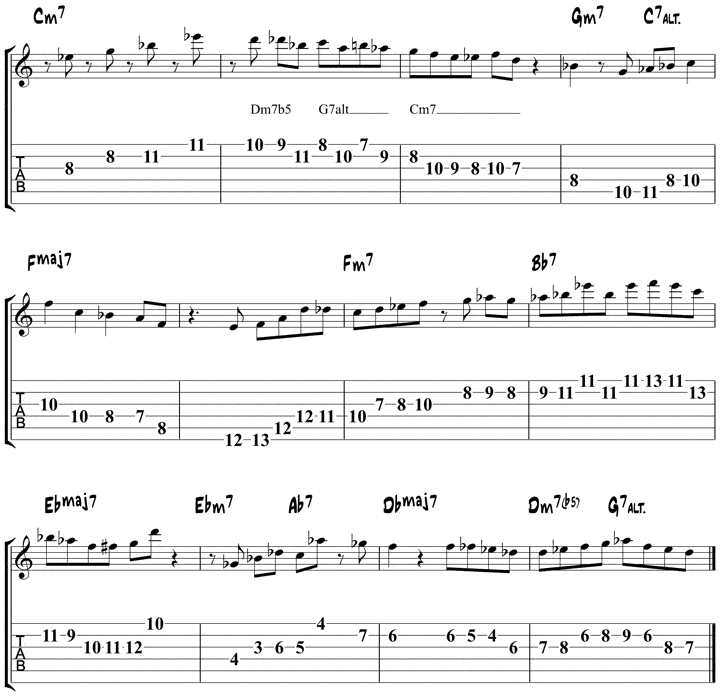
Long II V I Licks
Now that you learned some typical Wes Montgomery phrases over short 2 5 1 chord progressions, let’s have a look at some longer 2 5 1 progressions.
2 5 1 Lick 1 – C Major
The first lick starts with a series of arpeggios. The first 4 notes make a Dm7 arpeggio, followed by a Cmaj7 arpeggio, then again a Dm7.
The Cmaj7 arpeggio in the first bar contains all the tensions of Dm7:
| Cmaj7 | C | E | G | B |
|---|---|---|---|---|
| Played over Dm7 | b7 | 9 | 11 | 13 |
The last bar is built around a C triad arpeggio.
Listen & Play Along:

2 5 1 Lick 2 – C Major
The next lick over a 251 in C major has a nice chromatic line in the second bar, delayed by the Dm arpeggio.
Listen & Play Along:

2 5 1 Lick 3 – G Major
The next lick is played over a 251 in G major. The second half of the first bar consists of a chromatic line that is also used a lot by Pat Metheny, outlining a D7b9.
Listen & Play Along:

2 5 1 Lick 4 – G Major
Here’s another ii V I lick in G major, with a nice voice leading.
What is Voice Leading?
Voice leading is making the transition between chords in a chord progression as smooth or musical as possible. It is not only useful for comping, but also for single note soloing.
Listen & Play Along:
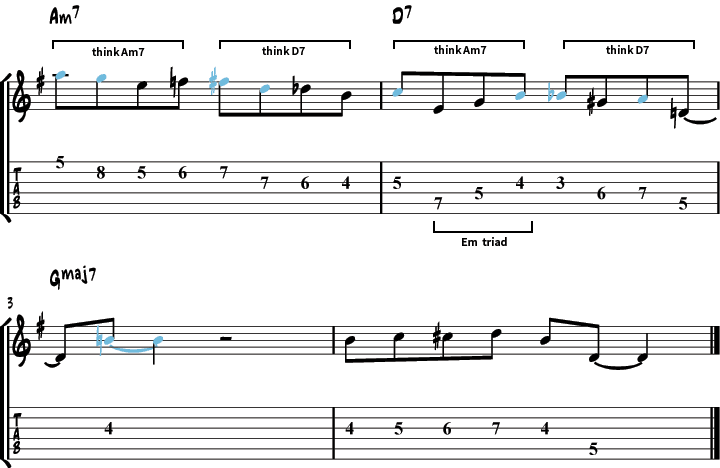
- The voice leading (the notes in blue) makes a decending line starting at the 1 of Am7.
- Although the rhythm section plays the 2 5 over 2 bars (1 chord/bar), the voice leading suggests an Am7 on beat 1 and 2 and a D7 on beat 3 and 4 of each bar, like this:
| Am7 D7 | Am7 D7 | - Bar 2 starts with an Em triad, which sounds like Am9.
- The other notes besides the voice leading are scale or chromatic tones.
2 5 1 Lick 5 – G Major
Here’s another good voice leading example between the b7 of D7 and 3rd of Gmaj7.
Listen & Play Along:

2 5 1 Lick 6 – F Major
This one’s a blues cliche, though in the hands of a master like Wes any cliche sounds good.
Listen & Play Along:
Minor Licks
Minor Lick 1 – D Minor
This minor lick is in the D Dorian scale with some added chromatics. Here is a sample D Dorian fingering to get you started if this scale is new to you (learn more about guitar modes here: The Beginner’s Guide to Guitar Modes & Scales):
Listen & Play Along:
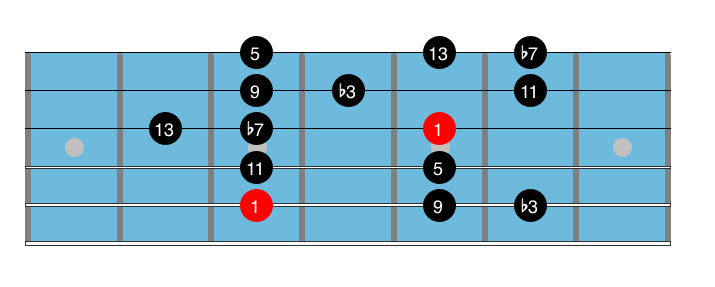
Listen & Play Along:

Dominant Licks
Dominant Lick 1 – Eb7
The first measure of this dominant lick is fairly straight-forward, except for a cool arpeggio on the 3rd beat of the phrase. Here, you are playing Dbma7 over Eb7, which is like thinking of a maj7 arpeggio from the b7 of a dominant chord
By doing so, you are highlighting all of the upper extensions in the Mixolydian mode:
| Dbmaj7 | Db | F | Ab | C |
|---|---|---|---|---|
| Played over Eb7 | b7 | 9 | 11 | 13 |
At the end of the first bar, you will find a commonly used Wes Montgomery rhythm, an 8th note followed by two 16th notes. This rhythmic pattern then continues for the rest of the second bar until you resolve the line to a Bb triad over a Bb7 chord.
Listen & Play Along:

Dominant Lick 2 – G7
A bluesy lick over G7 with double stops (playing 2 notes at once).
Listen & Play Along:

Octave Licks
One aspect of Wes Montgomery’s playing style that many people want to bring into their own playing, but often find difficult or don’t know where to start, is octave soloing.
To help you climb over this hump in the practice room, here is an octave soloing study over the tune Summertime.
Each phrase uses characteristic Wes Octave lines and concepts, which you can then break down and add to your own solos.
Octave Lick 1 – A7
This first octave lick is a bluesy line over an A7 chord, mixing the major 3rd (C#) with the blue note (C) to get that classic Wes sound.
Listen & Play Along:

Octave Lick 2 – 2 5 1 in G Major
Another approach Wes liked to use with octaves was to run a rhythm across a ii V I phrase, which you can hear and see in the next example.
Listen & Play Along:

Octave Lick 3
This next octave phrase uses a very common rhythmic pattern found in Wes’ solos, as well as a repeated motif that is altered in the second half of the line to fit the change in chords.
We often used repeated phrases such as this in his solos, where the rhythms and general shapes of the line are the same the second time around, but the notes are altered to fit any new chords in that second half.
Listen & Play Along

Octave Lick 4
Another common rhythm that Wes liked to use was quarter notes when playing octaves. You can see in this line, made almost entirely of quarter notes, that the notes themselves are built from arpeggio shapes.
Using arpeggio notes and quarter-note rhythms may sound simple enough, but they can add that Wes vibe to your octave solos, as sometimes it’s the simple things that make the biggest difference.
Listen & Play Along

Octave Lick 5
Here, you are using one of Wes’ favorite octave choices, the blues scale in a motivic fashion.
The blues scale may seem fairly basic of a choice, but it’s one that Wes loved to use in his playing, especially with octaves.
You will also notice a rhythmic motive being used throughout this phrase, with the second bar having slightly altered notes to create some variety during the line.
Listen & Play Along

Octave Lick 6
This last octave phrase uses diatonic notes to outline each key, F major and D minor. Notice the repeated notes in the first bar and the use of the off-beat rhythms in the second bar. Both are characteristic of Wes Montgomery’s octave sound.
Listen & Play Along

Octave Solo
Now that you have worked through each of these phrases on their own, it’s time to put them all together and play the entire solo over the changes to Summertime as a whole.
Backing Track
Listen & Play Along
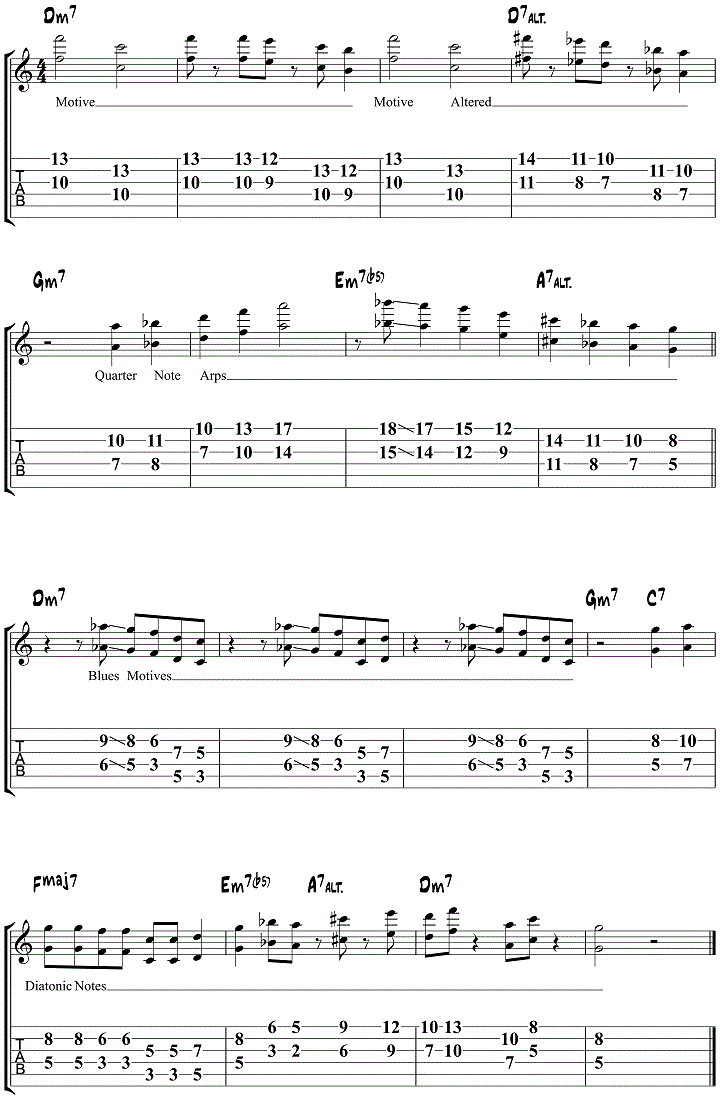
Chord Licks
There are three main aspects of Wes Montgomery’s playing style that most players dig into when working out Wes’ sound in their studies: single notes, octaves, and chords. This lesson concentrates on chord soloing, something Wes Montgomery was a master at. Although Wes makes chord solos sound as if it’s the most natural thing in the world, chord soloing ain’t easy and is something a lot of jazz guitarists struggle with.
In this section, you will learn how to play 5 Wes Montgomery chord licks, learn the theory behind these licks, and then apply them to a ii-V-I chord progression in your own comping and chord soloing phrases.
Chord Lick 1 – Bb7
This first Wes chord lick uses a number of Bb7 inversions (including 9ths), as well as a chromatic approach chord to finish the lick in typical Wes style.
Listen & Play Along:

Chord Lick 2 – Bb7
Here is a bluesy chord lick that uses a Bdim7 chord to create a Bb7b9 sound over the given chord change.
| Bdim7 Chord | B | D | F | Ab |
|---|---|---|---|---|
| Played over Bb7 | b9 | 3 | 5 | b7 |
Listen & Play Along:

Chord Lick 3 – 2 5 1 in F Major
To help you work out the following 3 licks in your practice routine, here is a backing track that moves through four different keys of a ii V I progression.
Listen & Play Along
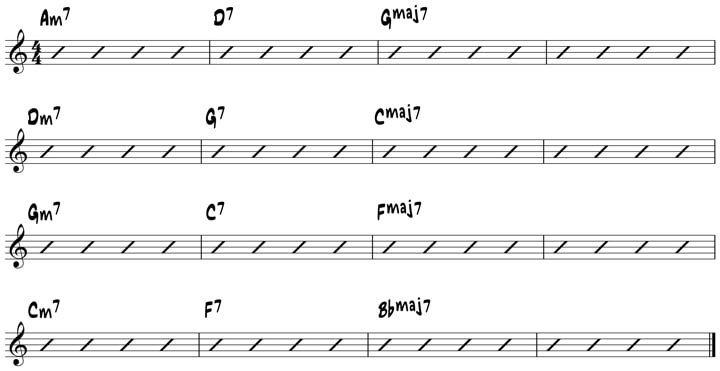
This Wes chord lick uses a few different techniques that can be found in many of Wes’ classic chord solos.
- The first technique is the chromatic sliding, which you can see between the F#m7-Gm7 and Emaj7-Fmaj7 chords. This is where you play the same chord shape one fret below your target chord, then slide into that target chord from there.
- You can also see a series of 7alt chords (D7alt-G7alt-C7alt), that build a dominant cycle progression. This is a common sub in Wes’ playing, and it builds a V7/-V7/-V7 progression in the voicings used within the phrase.
Listen & Play Along

Chord Lick 4 – 2 5 1 in F Major
The next Wes chord lick also features the chromatic sliding technique as you saw in the previous phrase, this time between the Amaj7-Bbmaj7 chords at the start of the bar.
As well, the Bbmaj7 over Gm7 superimposition produces a rootless Gm9 chord sound. So, if you ever have a m7 chord, you can play a maj7 shape from the b3 of that chord to produce a m9 sound in your playing.
The last concept worth exploring in this phrase is the Edim7 chord used over C7. This produces a C7b9 sound and can be used to bring a bit of tension to your dominant chords when applied to a comping situation.
Listen & Play Along

Chord Lick 5 – 2 5 1 in F Major
This last phrase uses a G7b9 chord sound in bar 1, over Gm7, which creates a V7/C sound before resolving to the C7 chord in bar 2 of the phrase.
When looking to spice up your ii-V-I comping ideas, one of the easiest and most common ways to do this is to play II7-V7-Imaj7, so you sub out the iim7 with a dominant 7th chord from the same root as you see here.
Listen & Play Along

Chord Solo
To help you take these licks from the technical side of your practice routine to the musical, here is a sample solo over a Bb blues that uses licks from this lesson in its construction.
Here is a backing track that you can use to practice this solo:
Listen & Play Along:
And here is the solo to practice. Go slow at first, learning each 4 bar phrase, as you learn the entire solo build in a typical “three-tier” approach that was characteristic of Wes’ playing.
Listen & Play Along:
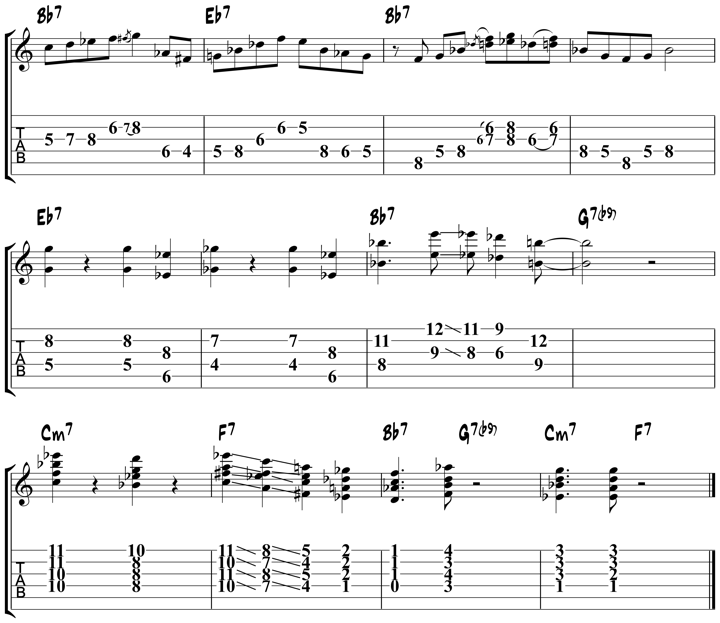
Blues Licks
One of the aspects of Wes’ playing that many guitarists explore in their studies is the blues, as Wes was a master of blues-inspired phrases and soloing over the 12-bar blues form.
In this section, you will explore a Wes blues solo, constructed using common concepts and phrases found in Wes’ soloing output over this commonly used jazz song form.
To help you get this solo under your fingers, each four-bar phrase is pulled out of the solo as a whole, analyzed, and laid out for you to practice on their own before combining them to form the solo as a whole. After you have learned any of these three phrases individually, which make up the solo as a whole when played back to back, try practicing these phrases in other keys.
Blues Lick 1
The first phrase of the solo is reflective of Wes’ blues scale soloing, where there is an opening phrase, the call, and a concluding phrase, the response.
By playing a call and response phrase within the context of a blues scale, Wes was able to keep a bluesy vibe in his solos without simply running up and down the blues scale.
The call and response concept brings a strong sense of organization to the line and the overall chorus whenever this concept is used to build an improvised line.
Listen & Play Along

Blues Lick 2
Another example of Wes’ use of call and response phrases, here you will see this concept applied to diatonic notes, rather than notes from the blues scale as you saw in the previous phrase.
You will notice that this call and response phrase> starts at the end of the previous line, which is where the audio example begins below so it includes the entire phrase.
There is also a short concluding lick (the C to D), at the end of the line that brings the longer phrase to a close.
Listen & Play Along

Blues Lick 3
The final phrase uses several ii V I concepts that are commonly found in Wes’ classic solos, blues or otherwise.
The first bar uses G7 in place of Gm7, creating a V7/V to V7 movement in that section of the tune.
Replacing the iim7 with a II7 chord is a common sub in a ii V I progression, and is a sub you can explore further in your studies as you dig into chord subs over ii V I changes.
The second bar features a tritone substitution, Gb7 over C7, which creates a large amount of tension, which then resolves nicely into the F7 chord in bar 3 of the line.
Using a tritone sub to create a iim7-bII7-I7 progression, is something that Wes and other legendary players often draw up to create a tension-resolution vibe in their improvised lines and phrases.
Listen & Play Along

Blues Solo
Now that you have worked out each phrase on their own; here is the solo as a whole for you to practice and take further in your jazz guitar practice routine.
To help you practice this solo further, as well as practice your improvisational approach to jazz blues in general, here is a blues in F backing track:
Listen & Play Along
Listen & Play Along
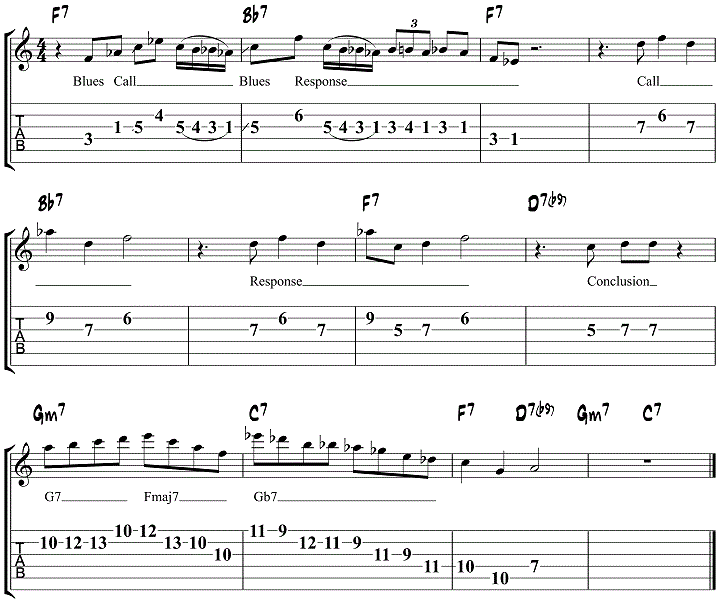
Wes Montgomery – Solo Organization
One of the concepts that you can learn from Wes Montgomery, beyond his choice of notes, is how he organized his solos.
Though he didn’t always use this concept, Wes played with the following formula to create engaging and highly intense solos, often over a jazz blues tune.
The formula is as follows:
- Bars 1-2 = Riff 1
- Bars 3-4 = Repeat Riff 1
- Bars 5-6 = Riff 1 Altered (rhythmically or melodically)
- Bars 7-8 = Riff 1
- Bars 9-12 = Anything else except the riff
By doing so, Wes was able to develop melodic ideas (the riff), as well as “cleanse the palette” of the listener before starting again at the top of the next chorus.
This formula can be shrunk down or expanded to fit other musical forms, such as 16 or 32-bar tunes. As long as you develop a riff for a good amount of time, then play something totally unrelated to that riff before moving on to the next riff, this concept works.
When first learning how to organize your solos in this fashion it’s best to stick to a strict outline before branching out and moving beyond that outline in your playing.
Wes Form Exercise Sample Solo
Now that you know how this Wes concept works, you’ll learn a simple solo written in that style.
Work this solo with the audio example until you can play it from memory with the backing track.
From there, begin to create your own riffs in the first 8 bars, keeping the “anything else” line as is.
Then, keep the blues riff as written by you make up the “anything else” section.
This approach to practicing teaches you the solo, the form concept, and how to solo with this concept in your own playing.
Listen and Play
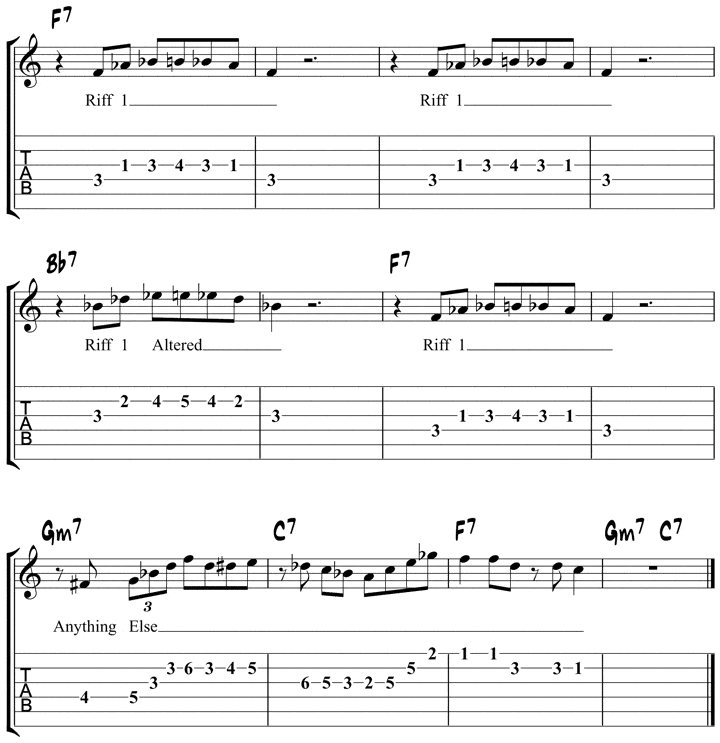

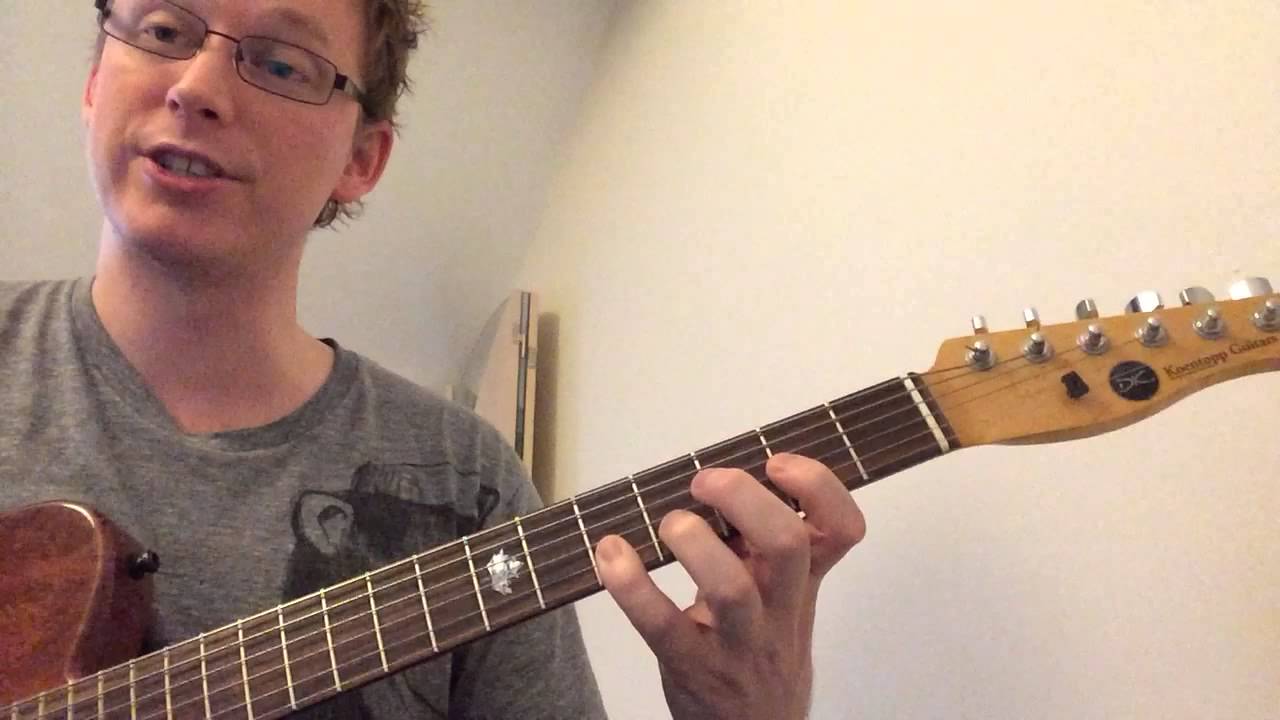


Thanks.
It can be safely said that the bars 9-10 of the solo organization exercise are based on the idea of transposition and transformation of the first riff to G with embellishments, which is veiled on the last line in pitches 2,3,4,9,10,11,12. This is also proved by melodic contour.
Helps alot simple and direct great foundation learning solo for an intermediate like myself
Thx
Outstanding, keep em coming
Thank you , it is very easy learning this way,
Very impressive. Thank you🙏🏻
Is the explanation of Altered Dominant Pattern correct?
The phrase feels like “D alt”
Of course the bassist is playing E7 and Am
I have a question on 2nd example from the end. The top says G- but between staves says G7 & B was played but implication was Bb in 1st bar to an F7 w/dim lick on 2nd bar. Is it G or G-? Don’t mean to nitpick but?.
In a ii V you can replace the iim7 with II7, it becomes the V7/V7 in this case. Fmaj7 over a G7 is something Wes used to do to create a G13sus sound. So think of it as G7-Gb7-F7
The Bb bluesy chord lick that uses Bbdim7 for Bb7b9 could have an Eb ( ala Fmin9) on bottom to break up parallel without the repeated 3rd (D) on the end ( Eb to D resolution)…just a thought. Super lesson as usual professor!
Nice Work!
Check out Your 8th swinging…
Wow, what a treasure trove of practice material. And from Wes, no less, thanks!!. Ok, finished talking, now where did I leave my
L-5?
Really fantastic. Thank you
All Rigth !!!! Great Lessons !!! Marvelous !!! Great Great !!!!
So impressed with your website! Lessons,samples, explanations, available material. Thanks!
Long live Jazz guitar on line
Are you a great teacher or what…… Fantastic
Very hip makes the sounds of Wes!
Excellent avec le backing
Great Liks…thanks
Really appreciated by all the players out there
Maybe a LT (leading tone).
Thanks very much. Great stuff. Brief comment on the notation of the dominant pattern. The E note after the trill is not played in the performance, and the lick seems better to me without it. Also a lot easier to play.
Thanks. That note is ghosted. It means it’s notated but you don’t necessarily have to play it. Just imply it. I often play those by fretting the note but not plucking it to give the ghost note feel.
dear Mr. warnock, I just finished viewing your you tube playing the song “Corcovado” , i really like this Bossa Nova and would like to learn this wonderful song. If possible please create a lesson for this and other appropriate Bossa nova songs. I found this video
exceedingly inspiring and look forward viewing any and all such related music.
Thanks! If you google my name and Blue Bossa or just Bossa you will find those lessons. Cheers. As well as this lesson
https://www.jazzguitar.be/blog/blue-bossa-guitar-chord-study/
This is the only kind of lick I can learn, haha. I like patterns too tho
what a delight…
Hi Matt, to my puny understanding, the major 7th note over a dominant 7th chord works because it’s resolved to the D natural which is the flat 7th of E7 or 11th of the Am chord it falls on. Is this how you think when you see something like this?
Hey
You can think of it that way for sure. It is a tension note, so you can see it as resolving to the D, or you can see all the tension notes as a collection that resolve to D. Either way of thinking will work no problem.
great!!!! thank you for this amazing work, on sharing and teaching good music.
Loving it, ,,,
Very nice-thanx.
Material muito bom. Os recursos técnodidáticos são excelentes para o ensino do Jazz. Parabéns,Thank you!
it’s a fantastic lesson
this is splendid
am liking it….it’s great…thank you sir
Simplemente excelente, gracias por el aporte
you are great
best wishes & thank you very much
Great stuff, Dirk! And “Summertime” is a great tune to use for this example. Thanks!
What software do you use to do the music G-clef and guitar tab as shown above? I think you are doing a great service to guitarist around the world!
Thanks. I use Sibelius for all musical examples.
love how you teach phrases then put them together for a solo
What an excellent lesson!!!
Thanks for explaining this beautiful solo and highlighting how the great Wes used these various patterns in such a simple way. Pure Genious! I will have a lot of fun with the backing track and octave playing.
Hi Dirk & Matt,
thanks for another masterpiece lesson and I feel sure that we all look forward to the E book
due for release on 4th November in the style of Wes’
I AM SORRY BUT TWO WORDS(JUST GREAT) ARE NOT ENOUGH FOR THESE WONDERFUL LESSONS!AH BUT ONE YES ONE WORD WOULD DESCRIBE ALL ‘QUINTESSENCE’.I WILL BE PURCHASING THE VOLUME 2 PREMIUM LESSONS AT WHICH POINT I WILL THINK OF ANOTHER WORD TO EPITOMIZE ITS ESSENCE.(WOW JUST REVERTED BACK TO MY SUPER HERO ALTER EGO SCRIPTOMAN.ITS BEEN YEARS.)
great lessons. thanks!
Excellent lessons. A signature sound made easy from my favorite jazz guitarist
a great lesson to learn cause it sounds so cool
Just great!
Excelente solo e muito bom para exercitar. Gostei muito. Bestial
Thank you, Matt. This should get me there.
Hi, I really like these lines. Thanks for the lesson.
I just had a first look at blues lick 1 and I have some doubts about the fingering. May I ask some advice?
I guess that the best way to start the riff is with the 3rd finger on the F. then 1st finger for the Ab. Then the 4th finger on the C? Here I have some doubts, because then I get some trouble on the first C in the 2nd bar. How to make the jump then to the F on the B-string? Anyone the same doubts? I hope someone can give me a little advice on this. Thanks! Best regards, xtof.
Hey,
on the recording I used the following fingering
3rd string F = 3rd finger
2nd string Ab = 1st finger
3rd string Bb = 3rd finger slid to C on same string with 3rd finger
2nd string F = 4th finger
Hope that helps!
Great lesson. I did the fingering a bit different, but what you did sounds great
Great lesson ! Thanks to all and to Matt for the simplicity of the V to V progression solving the questions !
Avec de telles explications sur les analyses c’est très facile d’apprendre surtout pour nous en Afrique qui voulons faire du Jazz sans le pouvoir.
Don’t know, who “the teacher” is. Is it Dirk or Matt? Whoever it is, a big big Thanx from me from Germany 🙂
Glad you dug the lesson Ric!
I have looked at some comments about this and if I may be so bold to suggest that someone may look at this in an alternative way -Start humming some riffs along to the tune (a bit like George Benson)then transfer what you like to the guitar, If you keep doing this you will build up a ever increasing collection of phrases; try using chord arpeggios and the cage system as a reference.
Great lesson!! I learned a great deal, the explanation was concise and I appreciated your analysis. Cheers mate!
Hey everyone. In blues lick 3, the G7 is outlined because of the B natural, and it’s a common sub to use II7 in place of V7. Becomes a V7 of V7 to V7 movement. The Fmaj7 outline is a diatonic chord. G7 comes from C major and Fmaj7 is the IV chord in that key. So its just a diatonic arpeggio choice.
The Fmaj to c7 is a 1to 5 to accentuate the dom chord (c7). In this case you play Fmaj (ionian) to the the tritone to create more tension. The notes E ‘ C ‘ A ‘ D which played isnt an Fmaj7th arp. It’s just a way of thinking. The 2 chord in Fmaj is an Gmin7 so there is a b flat. In this example there isa b played over the gmin. So to explain in modes, gmin, think g mixo to create the b / bflat bluesy tension. Then fmaj ionian or gmin dorian to c mixo, like an normal 2 – 5. But the 5 is an tritone. Once again, it’s a way of thinking…. hope this was usefull to you all.
Some really beautiful lines here ! You definitely can hear Wes vibes in those.
Great licks! But, I am also puzzled and curious about the first bar of blues lick 3. Apart from not getting the concept of the Fmaj7, how do you recognize the first four notes to be part of G7? Having the third and fifth of the Fmaj7 on beats 1 and 2, I would have never have guessed a connection to G7 instead of Fmaj7.
Hi Christian,
Since the Gm7 to C7 is out of the circle of 4th
you can change Gm7 to G7 to resolve to C
And you can always use IV over V. Like Fmaj7 against G7.
So Wes kind of re-harmonized the changes he was thinking
and forced them against the original changes.
This creates a little outside flavor to the line.
But this is impossible to learn in a piecemeal way.
One really needs a systematic way to approach
all the tools available in improvisation.
Cheers!
Ken
I wonder if you might explain the Fmaj7 chord 4 bars from the end of the blues solo just before the tritone Gb7. Thanks
Some how you have me convinced That I can actually do this. Thanks.
For that, I’m gonna keep trying. Woody
Thanks. As for the comments about theory…it can help a lot, especially when jamming or when playing as a sideman on casual gigs. Wes probably did read, at least some. Others who were/are great readers and were formally trained, as well as possessing an “ear” for it all: Joe Pass, Kenny Burrell, Charlie Byrd, Howard Roberts, Lee Ritenour, Al DiMeola, Johnny Smith….and the list goes on and on.
Dennis Budamir (sp) was a great reader, too & played sessions back in the day.
Excellent lesson!
This is great stuff, all of it. You are reaching everybody from beginners of jazz to seasoned players that are always willing to learn and be reminded of what they have forgotten! Thank you.
Phil, I like thomastik-infield medium strings. Either the “George Benson” or “Jazz” variety. You can get them at juststrings.com
Stan
Thanks for the lessons and books Dirk. I’ve been playing trombone for 35 years, and have just begun to try to play guitar: I’ve always loved jazz ever since I was a kid hearing my grandad’s Fats Waller records. True, many of the greats did not need to read music or know theory, us mere mortals need some help learning where we might go next or what could be possible. On a tangent, can anyone recommend some good flatwounds to go on my Godin 5th Avenue? I use Rotosound 12s at the moment.
I think that it is important to mention that with a few exceptions,usually offshoots of true innovators,most of these jazz guitarists did not read or write music,would not know about modes,2 5 1 progressions etc.Wes probably could not name the chords he used or know why or how they were named.For these guys it was all about having a good ear for harmony,then playing,learning TUNES,standards.But one does not have to LEARN the chords for each song,rather HEAR the empirical recurring ways that harmony is assembled.Johnny Smith then used the harmonic structure of Softly as in a Morning Sunrise for walk don’t run,and Shearing used Love Me Or Leave Me to write Lullaby Of Birdland..These WERE guys able to read/write music.In jazz(good jazz),it is ideally being able to compose new melodies over existing chord sequences on the fly.My definition of not so good jazz is playing as many notes as possible that are enharmonically correct,in order to impress non musicians as to how fast you can play.In other words,as Shakespeare wrote….sound and fury signifying nothing!
Thank you. Amen ! Most teach-yourself blues and jazz books devote many pages to theory with the admonition to memorize the notes on the fretboard and all the permutations of the chromatic, diatonic and pentatonic scales. Nothing wrong with that, if that’s what rings your bell, but I don’t think that’s absolutely necessary. I don’t think guitarists like Wes and B.B. King started off that way – they played with their ear and heart.
The point of music theory is that it gives you the tools to analyze why the players we admire so much sound so good. Theory will not in and of itself make you a great player. But it CAN help you understand some of what the giants did, perhaps even allowing us to borrow from them and put it into our own playing. I will never be a Wes Montgomery… won’t even come close. But it does my heart good to look at something he did and be able to figure some of it out and apply it to my playing. I can’t help but get better.
regards,
Paige
Right on Paige.. Not everyone has a good ear (much less a great one).
Your ear CAN be developed but often music theory can be a short cut
to learning for some of us.
I personally believe we need to balance theory and playing by ear which
can be hard in itself. Playing by ear can get you some quick songs but theory
can help create new ones.
I agree. Quincy Jones taught Ray Charles theory through Braille & I personally would hire someone like Mitch Holder, ( transcribed Howard Roberts albums) who is a great studio player/educator/reader rather than take a chance unless I know the guy can improvise something workable. Hank Mancini wrote guitar parts & Tommy Tedesco ended up playing what he wrote, although he did try to do his own thing first Lol. You think men would’ve walked on the moon without anyone reading/writing. There are some anomalies to the rule though but they’re few & far between. Nothing good comes easy or everyone could play like Wes, Joe, etc.
I agree that he probably did not know conventional names, but he obviously had his own concept, good ear is enough to hear, maybe to sing, but not to play at least even quite simple jazz is complex enough to play over it occasionally – especially guitar… you have to organize it practically, whether use common theory or self-taught.
But I think applying mode concept to such a melody phrase is wrong. he plays no mixolidian… musically all he does is playing in c major key (since it is cadance) with addition of cromatic blues tones.
besides I think he practically used chord shapes – we have to use Dm7 shape arpeggio (how you play it from f or from c or from d is up yo you, then line over G7 (F is ok for c major key and belongs to G7th chord – no need to involve extra modes here) – and then C around root – how add the chromatic tones (here blues) depends on you feel of style, your tase, imagination.
This mode approach can bring cliche in playing..
Wes’ solos are very integral
To learn an art, doing some theoretic study helps a lot. Improvising is a kind of composition on the spot. If you understand music it supports your creativity and makes life more simple. For instance, trying to improvise on Giant Steps causes a lot of headache for some. But in fact its has a very simple structure. Miles Davis gave up playing on chord changes and switched to modal to feel more free. If you really understand the logic of chord sequences you will be less inclined to run away from them.
I enjoyed your demonstration, from Brazil, Ezequiel
Nice!!
Nice to see your stuff on here mate. Tasty licks.